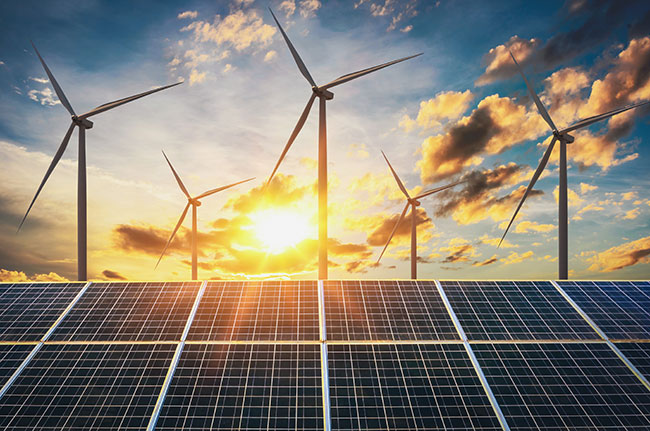
Features
Sustainability
Technology
A holistic approach to RAS energy efficiency
June 15, 2021 By Maddi Badiola
 Using green energy will significantly increase energy efficiency in RAS production. Photo: ADOE STOCK: lovelyday12
Using green energy will significantly increase energy efficiency in RAS production. Photo: ADOE STOCK: lovelyday12 Properly designed RAS can be the most environmentally-friendly systems in the aquaculture industry. With credit to the blue revolution and the exponential increase of seafood consumption, these systems are meant to be the most sustainable across the food industry. They are environmentally, technologically, socially and economically sustainable. But once more, the question without the desired answer, is there: Is the industry looking deeply and taking into account energy effectiveness?
Remember that energy does not only impact the environment, it impacts the technology; more efficient systems, less energy required per kilogram produced. It attracts society awareness, as people are looking at pollution more than ever before. Carbon footprint has become a very important factor of either success or failure of many products. And lastly, linked to society, energy influences the economy of a product, making it cheaper or more expensive according to the operational costs incurred. Thus, energy is among all factors that account most in the production chain, impacting four out of four pillars of sustainability: human, social, economic and environmental.
To facilitate the process of replacing existing energy sources with sustainable alternatives and to minimize environmental impact, energy efficiency in consumer goods, building system and manufacturing systems has to be improved. This includes fish production systems and equipment.
Where should the industry look to?
RAS has always been seen as a loop with different components connected – a filter, biofilter, disinfection units, oxygenation, skimmer, CO2 stripper – all of them connected through pipes and valves where water flows constantly pushed by a pump. In this manner, energy consumption can be difficult to decrease as many different pieces of equipment take part in the equation. So, let’s at these systems as a whole machine; a machine that integrates all of the equipment in to one, and a machine with a nameplate where it states the electrical power usage. Controlling one complete equipment package could be easier than controlling several smaller ones.
The nameplate indicates the worst-case energy usage estimate of a machine, while the actual energy demand will vary depending on the application of the equipment. In my previous articles, energy auditing and energy measurement have been pointed out as a requirement within the industry. Neverthelss, at the same time, it seems tedious and demanding to be monitoring each piece of equipment on the loop. Thus, what if with one measurement, monitoring the energy demand and consumption, it could be controlled?
The best way to measure and monitor the dynamics of a machine is to use a power meter, measuring the actual power consumed over the course of time. Measure power usage for each operating mode of the machine, and during all parts of the programmed process to better determine when energy consumption is the highest and identify areas for improvement. The amount of energy consumed at each production state can be determined using proper software and analysis. Through this power measurement data, the energy cost of a machine idling during production stops can be identified and reduced if found to be excessive. Monitoring power can also point to process and scheduling problems that cause unnecessary energy usage.
Design factor
There are many ways machine design affects efficiency. Something as simple as supplying excess voltage to the machine can waste energy. Shut it off or turn it down. With proper power measurement and monitoring in place, effective control of machines becomes an adaptable and adjustable capability. Using power measurement data, machines and equipment can be shut down when not needed, or turned down where possible. With proper monitoring of machines and equipment, energy usage can be optimized.
Understanding where and when energy is consumed in a machine is an important step to reducing energy consumption. To better understand the energy flow and consumption of the machine, it would be beneficial to develop an energy flow map. From this map, opportunities for improvement can be identified along with energy-related features. After creating a map, models can be generated that will help predict energy consumption and allow for optimization of the machine and a more sustainable design of the machine. Also, with the proper software and networking, this data can also be pushed to operators, technicians, and management in a variety of ways. Management may see the energy-efficiency data on a report analyzing machine efficiency. Manufacturing engineers can have access to this data on their tablet or smartphone for quick analysis and action, and the operator can view the data on a local display to ensure safe operation.
In the technology revolution century that we are in, it should not be any problem to get all the production chain employees involved in such an important element as energy, the factor impacting four out of four pillars of sustainability, the factor that makes the change between technologies, the factor that could help make an industry and/or a product a success.
Maddi Badiola, PhD, is a RAS engineer and co-founder of HTH aquaMetrics llc, (www.HTHaqua.com) based in Getxo, Basque Country, Spain. Her specialty is energy conservation, lifecycle assessments and RAS global sustainability assessments. Email her at mbadiolamillate@gmail.com or contatct her through LinkedIn, Facebook and Instagram.
Print this page